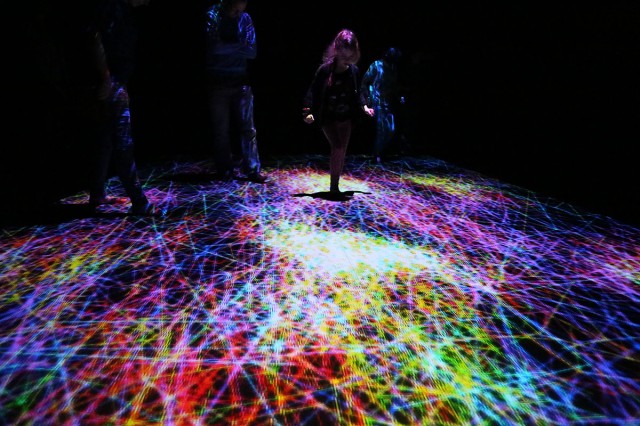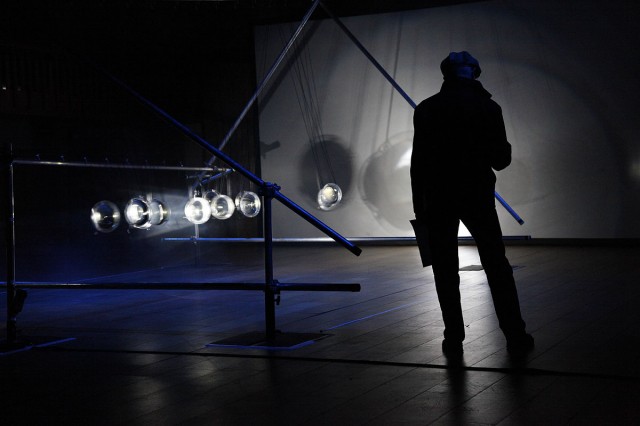Remembering Becs Andrews (1978-2016)
Stage designer and visual artist Becs Andrews died earlier this month, aged just aged 37. Laura Robertson recalls a fiercely talented and charismatic individual who gained widespread acclaim for a prolific, richly imagined artistic practice…
Imagine: an enchanted island, formed from mountains of discarded trousers and jumpers; a jumbled explosion of colour washed up on the shore… This was the unforgettable impact of stage designer and visual artist Becs Andrews, who unveiled a new version of The Tempest last September at Newcastle’s Northern Stage. Garnering rave reviews from the Guardian – ‘Laundry-room Shakespeare spins enchantment’ — The Stage – ‘The landscape she has created is exciting to the eye… a brilliantly rich backdrop’ – British Theatre Guide – ‘A treat for the eyes’ – and more, those in the industry that hadn’t yet heard Andrews’ name might have been surprised by the surreal scope of her work. Friends and colleagues wouldn’t have expected anything less; we recoginised a rare talent, a charismatic, confident artist destined for stardom.
The Tempest’s director Phelim McDermott remembers meeting Andrews to see how she envisioned the reinvention of the play: “Her studio walls were covered in extraordinary pictures of flotsam and leviathans of plastic sea debris. Becs told me she had restarted drawing whilst we were working together and she had loved it. Something she had not done for a while had been rekindled. This produced some beautiful, fantastical costumes.”
A collaboration ensued that formed the very core of the production, revealing Andrews’ unique talent. McDermott continues: “There was something intuitive going on as, although the ideas and images came first, they retrospectively looked like they had grown organically from the text. We decided that mountains of clothes would become our island. I told her not to hold back in how far she pushed the idea and she didn’t. The whole set was alive and transformative.
“Her design caught something magical, with much dreaming space for all the other ideas that are present in The Tempest. Her set did a thing which great design can sometimes do: help you hear things in the text you’d never heard before. A haunting world and a marvellous playground for the performers.”

Andrews had formed an extraordinarily successful freelance career since graduating in 2002, designing more than 55 stage concepts for theatre, opera, dance, film and TV – including for the Actors Touring Company, English Touring Theatre, The National Theatre, Birmingham Royal Ballet, Edinburgh International Festival, BBC, and many regional theatres and organisations throughout the UK. Her work often crossed, tested and united divergent disciplines and tools: klezmer and classical music, still photography and abstract choreography, digital technology and biology, costume design and the natural landscape.
She won five significant awards in her lifetime: the DARE Fellowship in Scenography, Opera North/University of Leeds (2013); the World Stage Design Exhibition (2009); the Fringe First Award, Edinburgh Festival (2007); represented the UK at Prague Quadrennial (2003); and was the Overall Winner of the Linbury Prize for Stage Design (2003), which led to a dramatic reimagining of the artist Jeff Koons for a production of the same name (ATC/ICA, London) – featuring a giant Kinder Egg, balloons as ‘airhead’ clubbers, and a sex scene via a game of twister.
Andrews produced ground-breaking sets for the Royal Opera House on many occasions (2007-14), including children’s choral opera On The Rim of The World (2009); television-inspired, dystopian dance piece Remote (2011); and electronic Faustian opera The Crackle (2013), which resembled a giant, interactive bar code. It was at ROH that Andrews collaborated with director Bijan Sheibani for the third time, on Through His Teeth (2013-14): a critically acclaimed psychological thriller following a woman seduced by a ruthless and duplicitous car salesman.
“She brought wonderful, elegant ideas to the project”, remembers Sheibani. “Simple black screens with small holes which, when they crossed one another, would make these magical ripples. It was perfect for a dark opera about a fake MI5 agent. I don’t know where she got her ideas from — they were often very science based and yet there was an anarchy and a wildness to them, and they were always appropriate and unearthing something from deep within the play.”
Born in Bath, to parents Pippa and David Andrews, Andrews graduated from Hayesfield Girls’ School in 1996 before studying a Diploma Foundation in Art and Design at the City of Bath College until 1997. Discovering a natural aptitude for and love of the arts, she attended the Ruskin School of Drawing and Fine Art at Oxford University to study BA Fine Art (1997-2000) and Master of Fine Art (MFA) (2011), in addition to BA Theatre: Design for Performance at Wimbledon School of Art, University of the Arts London (2000-02).
Alongside her blossoming career as a stage designer, Andrews continued work as a visual artist and producer; making the move to Liverpool in 2006 which would become her home for several years. She joined independent arts collective, gallery and studios The Royal Standard, meeting many friends and future collaborators. This is where I first met Andrews in 2008 as a fellow studio artist; fresh from university, I had much to learn from her furious work ethic. In the midst of a prolific production period, surrounded by assistants and meeting what seemed like an endless line of theatre and arts professionals, I was amazed at Andrews’ passion and professionalism, and decided to make myself useful and follow her example. I admired her immensely.
That same year, Andrews brought a faded, transatlantic glamour to Liverpool 2008 European Capital of Culture with The Quiet Little Englishman; writer Esther Wilson’s biopic of Hollywood sound engineer George Groves. Wilson commented: “The Quiet Little Englishman explored how one person’s creativity can change the world. George and Becs had a lot in common. True artists often do.”
The following year, in Liverpool in May 2009, Andrews married her university sweetheart, evolutionary biologist Professor Michael Brockhurst; a partner who shared her love of science, technology and the arts.
Artist Laurence Payot became close friends with the couple; in Payot, Andrews found someone with whom she could discuss the challenges, complexities and rare pleasures of creative making. Payot remembers Andrews’ artistic practice – which included over 25 national installations and exhibitions, including at the V & A, Ruskin School, Battersea Arts Centre and Edinburgh Fringe Festival — as reflecting a “curiosity and hunger for life.”

“With her recent work,”, Payot continues, “fuelled by discussions with her husband, Becs had great visions and instinctive feelings about what it is to be alive and feel the invisible energies that makes us who we are for such a short space of time.”
On Andrews’ 2014 video installation and camera obscura, Gold Dust – which was selected for the Royal Society’s 2015 Summer Exhibition entitled Enlightenment, and was inspired by the search for the Higgs Boson, or ‘God particle’ — Payot remarks: “What a beautiful title for a piece of work, a manifesto for a way of looking at the world.”
As the DARE Fellow in Scenography (2011-14), a joint position between Opera North and the School of Performance and Cultural Industries at the University of Leeds, Andrews developed an experimental practice spanning art installation to interactive digital media. Her personal mentor at the university, Dr Scott Palmer, recalls “a formidable talent”; continuing: “Phase Revival: An Optical Harmonica — a kinetic installation using swinging lenses and light — was a particular highlight. And when it was exhibited at Leeds Light Night in 2013, it drew such large crowds [6000 on one night] that audiences needed to queue for access despite the large space.”
Dominic Gray, Projects Director at Opera North, agrees, calling her “a real visionary… Becs worked happily with scientists and singers, with school children and philosophers, and always brought new and illuminating ways of seeing and thinking.”
At the time of her death, Andrews was undertaking a Visiting Research Fellowship at the Department of Music, University of York, in order to further develop her work with music and medical imaging technology within live, performative environments. It was here that she created perhaps her most ambitious artwork: Transmission, made for the York Festival of Ideas in 2014 in collaboration with her husband Michael, and universities of York, Bristol, UWE and Falmouth.

Described as “mind blowing” by audience members, Transmission used performance to conceptualise infectious disease evolution, using sound and video triggered by sensor-wearing dancers. Composer, sound artist and Post Doctoral Research Assistant Dr. Jon Hughes worked with Andrews on this at the University of York and many other creations, including Gold Dust, Phase Revival and Terranium: a stunning contemporary dance piece set in an inflatable bubble on the North York Moors and the Cornish coast.
“We had a rare thing”, Hughes recalls; “a close friendship that also worked really well as a professional artistic collaborative partnership. She could do so much and had such a lot of talent and intelligence. She was an inspiring, exciting and talented person to work with.
“It’s a real loss for me, to no longer be able to witness the unfolding of her story, of her art, life and work, how it was going to develop and move forward over the coming decades.”
Her death will be keenly felt; the arts has lost someone uncommonly talented. Andrews is survived by her parents Pippa and David Andrews, younger brother Dan and husband Michael.
Becs Andrews, stage designer and visual artist, born 10 January 1978, died 6 January 2016, aged 37.
Laura Robertson
See more of Becs Andrews’ amazing work here: becsandrews.com
Read “The world has lost a great talent”: Tributes Paid To Artist Becs Andrews





